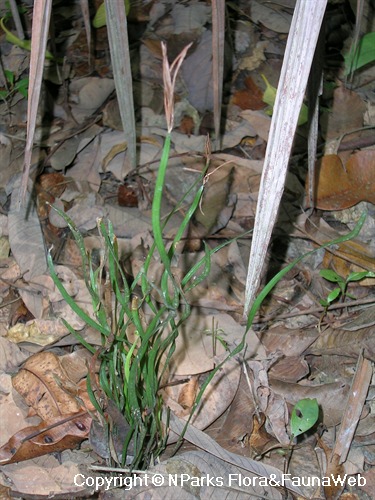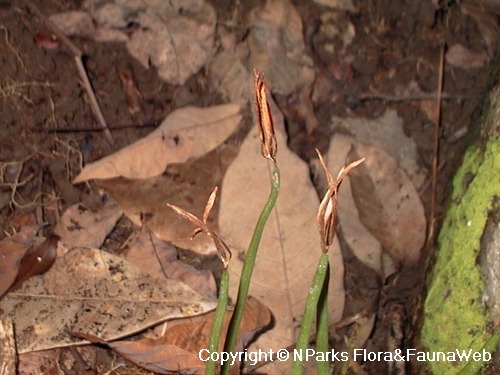
Back
Actinostachys digitata (L.) Wall.
| Family Name: | Schizaeaceae |
| Synonyms: | Schizaea digitata (L.) Sw. |
| Common Name: | Grass Fern, Paku Rimba |
Name
Classifications and Characteristics
| Plant Division | Ferns & Lycophytes (Non-Seed Vascular Plants) (Fern) |
|---|---|
| Plant Growth Form | Herbaceous Plant |
| Lifespan (in Singapore) | Perennial |
| Mode of Nutrition | Autotrophic |
| Plant Shape | Grassy |
| Maximum Height | 20 cm to 35 cm |
Biogeography
| Native Distribution | Madagascar, tropical Asia to Polynesia |
|---|---|
| Native Habitat | Terrestrial (Primary Rainforest, Secondary Rainforest, Coastal Forest, Disturbed Area / Open Ground) |
| Preferred Climate Zone | Tropical |
| Local Conservation Status | Native to Singapore (Endangered (EN)) |
Description and Ethnobotany
| Growth Form | It is a fern with a small 3–4 cm long rhizome and erect, grass-like fronds. |
|---|---|
| Foliage | Its fronds (leaves) are erect, grass-like, 20–35 cm by 2–3.5 cm, with a prominent midrib, and bearing at the apex a digitate group of up to 18 fertile lobes, 2.5–4 cm by 1 mm. |
| Reproductive Parts - non-flowering plant | The sporangia are arranged in 2 double rows and almost covering the lower surface of the lobes. |
| Habitat | It grows in open habitats such as forest gaps, as well as lowlands, inland, hill, dipterocarp, and secondary forests. It occurs locally in Pulau Tekong and Pulau Ubin (Chek Jawa). |
| Cultivation | It can be propagated by spores. |
| Etymology | Latin digatata, fingered, possibly referring to the grass-like fronds (leaves) |
Landscaping Features
| Landscaping | It can be grown in full sun to partially-shaded areas in parks for its grass-like form. |
|---|---|
| Desirable Plant Features | Ornamental Foliage |
| Landscape Uses | Parks & Gardens, Small Gardens |
Fauna, Pollination and Dispersal
| Seed or Spore Dispersal | Abiotic |
|---|
Plant Care and Propagation
| Light Preference | Semi-Shade, Full Sun |
|---|---|
| Water Preference | Moderate Water |
| Plant Growth Rate | Fast to Moderate |
| Rootzone Tolerance | Moist Soils, Well-Drained Soils, Shallow Media |
| Propagation Method | Spore |
Foliar
| Foliage Retention | Evergreen |
|---|---|
| Mature Foliage Colour(s) | Green |
| Mature Foliage Texture(s) | Leathery |
| Foliar Type | Simple / Unifoliate |
| Foliar Shape(s) | Non-Palm Foliage |
| Foliar Margin | Entire |
Image Repository
Others
| Master ID | 278 |
|---|---|
| Species ID | 1574 |
| Flora Disclaimer | The information in this website has been compiled from reliable sources, such as reference works on medicinal plants. It is not a substitute for medical advice or treatment and NParks does not purport to provide any medical advice. Readers should always consult his/her physician before using or consuming a plant for medicinal purposes. |

